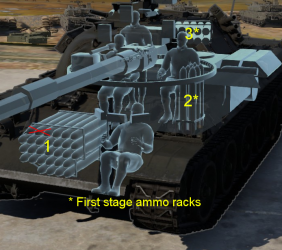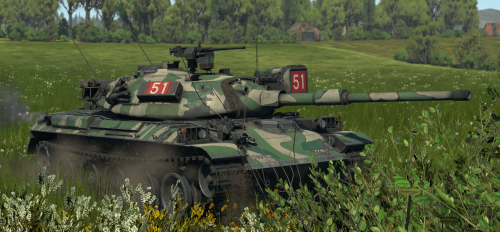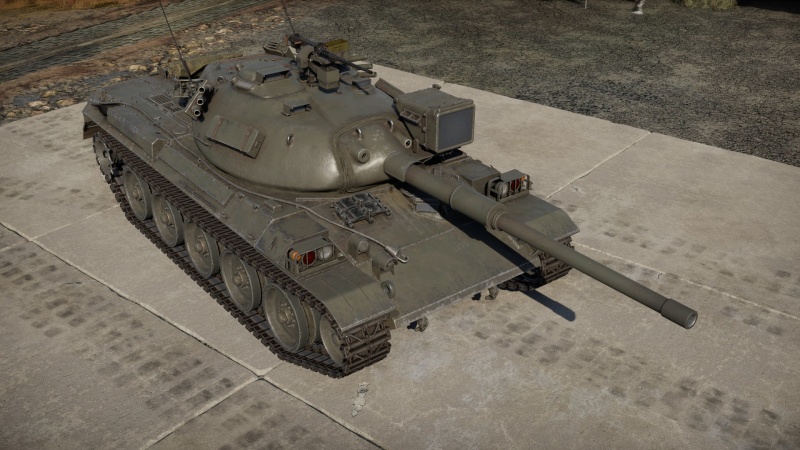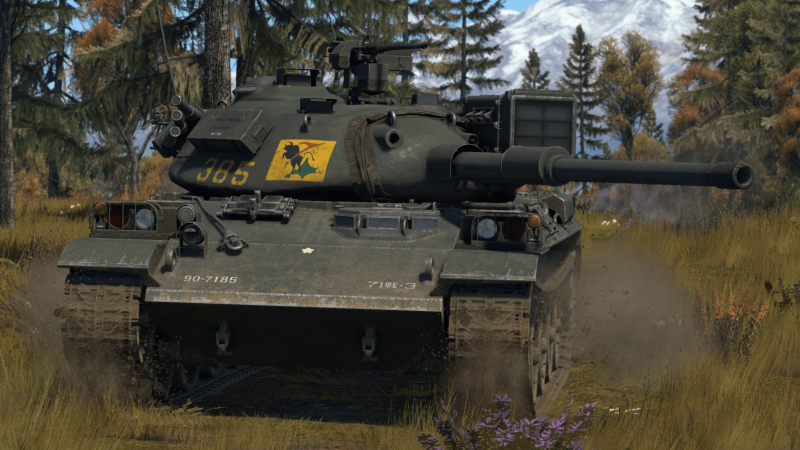Type 74 (C)
| This page is about the Japanese medium tank Type 74 (C). For other versions, see Type 74 (Family). |
Contents
Description
The Type 74 (C) is among the earliest production variants of the Type 74, featuring the early ammunition set for the 105 mm L7A3 cannon. It was built up as the production model for Japan's 2nd generation of MBTs to combat tanks such as the T-62 and compare to the M60 or Leopard 1, while supplementing and replacing the Type 61. While a feature-full tank with hydropneumatic suspension and an effective 105 mm L7A3 cannon, it was a pretty late Gen 2 entry, as the 3rd generation of MBTs (such as the Leopard 2 and M1 Abrams) would enter service just a few years later.
The most distinctive difference between the Type 74 (C) and the subsequent Type 74 (E) is the lack of a thermal shroud around the 105 mm L7A3 cannon (this feature was introduced in the Type 74 (D) variant).
It was introduced in Update "Direct Hit". As the earliest of the Type 74s, and has only APDS, HEAT and HESH ammunition. It does not have the APFSDS rounds that the later versions have. It has average mobility and a hydropneumatic suspension system that allows it to adjust its height and angle according to the terrain. It also has a laser rangefinder and a warning system that make it effective as a sniper.
General info
Survivability and armour
Armour type:
- Rolled homogeneous armour
- Cast homogeneous armour (Gun mantlet)
| Armour | Front (Slope angle) | Sides | Rear | Roof |
|---|---|---|---|---|
| Hull | 40 mm (74°), 80 mm (65°) Front glacis 80 mm (57°) Lower glacis |
35 mm (44°) Top 30 mm, 10 mm (55-56°) Bottom |
20 mm Top 25 mm (47-48°) Bottom |
25 mm |
| Turret | 132 mm (27-53°) Turret front 200 mm (34-73°) , 150 + 170 mm (0-44°) Gun mantlet |
132 mm (5-57°) Front 67 mm (37-47°) Rear |
37 mm (17-39°) | 67 mm Front 37 mm Rear |
| Cupola | 80 mm | 80 mm | ||
Notes:
- Suspension wheels and tracks are both 20 mm thick.
- Has additional 10 mm mounting plates scattered on the front hull
- The Type 74's hydropneumatic suspension means it could vary the sloped angle of its armour towards the enemy.
- Hull roof is rated to be 25 mm effective against HE.
As with most medium tanks of the rank, the hull of the Type 74 (C) is only capable of stopping some autocannon fire and has very vulnerable sides, however, the turret armour of the Type 74 (C) is closer to US and British turret armour level. While it's unlikely to stop most APFSDS, it is very likely to deflect stray APDS and APHE. Light tanks will likely have to get close and personal to penetrate it, as penetrating cupola even with APDS belt is a challenge due to its size.
The advantage can be kept even when creeping onto the enemy high ground by using hydropneumatic suspension before driving uphill to not allow the enemy to fire at the roof. In rare cases, the tank can "duck" behind cover to hide at least a portion of the turret from enemy fire.
Mobility
| Game Mode | Max Speed (km/h) | Weight (tons) | Engine power (horsepower) | Power-to-weight ratio (hp/ton) | |||
|---|---|---|---|---|---|---|---|
| Forward | Reverse | Stock | Upgraded | Stock | Upgraded | ||
| Arcade | 59 | 9 | 38 | 1,348 | 1,660 | 35.47 | 43.68 |
| Realistic | 54 | 8 | 769 | 870 | 20.24 | 22.89 | |
Modifications and economy
With the Type 74 (C) offering M456 HEAT-FS over the STB-1, it still has to be researched at rank III. While it's best to research parts and FPE first, priority should lie with getting the laser rangefinder, after which HEAT-FS and mobility can make a major difference in the vehicle's performance.
Armaments
Main armament
| 105 mm L7A3 | Turret rotation speed (°/s) | Reloading rate (seconds) | |||||||||||
|---|---|---|---|---|---|---|---|---|---|---|---|---|---|
| Mode | Capacity | Vertical | Horizontal | Stabilizer | Stock | Upgraded | Full | Expert | Aced | Stock | Full | Expert | Aced |
| Arcade | 50 | -6°/+9° | ±180° | Two-plane | 22.8 | 31.6 | 38.4 | 42.5 | 45.2 | 8.71 | 7.70 | 7.10 | 6.70 |
| Realistic | 14.3 | 16.8 | 20.4 | 22.6 | 24.0 | ||||||||
While the 105 mm gun is relatively equal to one of other nations. It has all the same shell types of NATO tanks at its BR range. The Type 74 (C) also has a laser rangefinder, which makes it really easy to check aim in RB, compared to tanks it fights in down-tiers and sometimes even in up-tier.
The gun depression is somewhat limited at -6°, but the vehicle's hydropneumatic suspension can be used to compensate for this to -12°.
Ammunition
| Penetration statistics | |||||||
|---|---|---|---|---|---|---|---|
| Ammunition | Type of warhead |
Penetration @ 0° Angle of Attack (mm) | |||||
| 10 m | 100 m | 500 m | 1,000 m | 1,500 m | 2,000 m | ||
| M392A2 | APDS | 350 | 347 | 333 | 317 | 302 | 287 |
| Type 75 | HESH | 127 | 127 | 127 | 127 | 127 | 127 |
| M456 | HEATFS | 400 | 400 | 400 | 400 | 400 | 400 |
| Shell details | ||||||||||||
|---|---|---|---|---|---|---|---|---|---|---|---|---|
| Ammunition | Type of warhead |
Velocity (m/s) |
Projectile mass (kg) |
Fuse delay (m) |
Fuse sensitivity (mm) |
Explosive mass (TNT equivalent) (kg) |
Ricochet | |||||
| 0% | 50% | 100% | ||||||||||
| M392A2 | APDS | 1,478 | 4 | - | - | - | 75° | 78° | 80° | |||
| Type 75 | HESH | 760 | 10.8 | 0.1 | 4 | 3.89 | 73° | 77° | 80° | |||
| M456 | HEATFS | 1,174 | 10.5 | 0.05 | 0.1 | 1.27 | 65° | 72° | 77° | |||
Ammo racks

| Full ammo |
1st rack empty |
2nd rack empty |
3rd rack empty |
Visual discrepancy |
|---|---|---|---|---|
| 50 | 17 (+33) | 10 (+40) | 1 (+49) | Yes |
Notes:
- Shells are modeled individually and disappear after having been shot or loaded.
- Racks 2 and 3 are first stage ammo racks. They total 16 shells and get filled first when loading up the tank.
- These racks are also emptied early: the depletion order at full capacity is: 2 - 3 - 1.
- Simply not firing when the gun is loaded will move ammo from racks 1-8 into rack 9. Firing will interrupt the restocking of the ready rack.
- The visual discrepancy concerns racks 1 and 3.
- Rack 1 has 3 shells which, while modelled in the rack, are never present (crossed out shells).
- Rack 1 is modelled as 30 shells but contains 34 shells.
- Rack 3 has a shell which remains in the rack even after having been shot.
Optics and night vision
| Type 74 (C) Optics | ||||||
|---|---|---|---|---|---|---|
| Type of optic | Magnification | Night Vision Devices | ||||
| Image Intensifier | Thermal Imager Resolution |
Notes | ||||
| Resolution | Light Mult | Noise Level | ||||
| Gunner's Sight | X8 - X16 | 800X600 | 8.0 | High | Not Fitted | Image intensifier unlocked by "NVD" modification (tier 4) |
| Commander's View | X6 | 800X600 | 8.0 | High | Not Fitted | Image intensifier unlocked by "NVD" modification (tier 4) |
| Driver's View | X1 / 3PV | 800X600 | 5.0 | High | Not Fitted | Image intensifier unlocked by "NVD" modification (tier 4) |
Machine guns
| 12.7 mm M2HB | ||||
|---|---|---|---|---|
| Mount | Capacity (Belt) | Fire rate | Vertical | Horizontal |
| Pintle | 600 (200) | 575 | -10°/+60° | -180°/+80° |
| 7.62 mm Type 74 | ||||
|---|---|---|---|---|
| Mount | Capacity (Belt) | Fire rate | Vertical | Horizontal |
| Coaxial | 4,500 (250) | 701 | - | - |
While it's not recommended, it's still possible to use 12.7 mm to fight light tanks like AUBL/74 HVG or Rooikat Mk.1D and most SPAA tanks at <100 m range.
Do not charge them with just the MG, especially at long range, as even poorly armoured rank V light tanks can survive frontal MG fire long enough to disarm and explode Type 74 - let them come to you, hit them with the main gun and ensure they never move again by firing at their sides or flat parts, while hiding yours.
Any melee oriented light tanks like BMP-2 or Warrior with add-on armour will have enough armour to absorb the MG fire and will greet Type 74 back with point blank ATGM attack, which machine guns will be unable to stop at such range.
Usage in battles
As all Type 74s, they closely resemble and play like the Leopard 1s while providing slightly better protection in exchange of top speed and stock depression, which Hydropneumatic suspension compensates for up to -12°.
As the earliest in-game production model of the Type 74s, just coming after the STB-1 it changes up the game with a single shell: M456 HEATFS. While overall gameplay remains the same compared to the rest of the Type 74s, the drawback of only providing HEATFS can be negated by the lower rating of the tank facing against easier-to-punch-through vehicles and less protected vehicles against chemical penetration. All the tools that make the tank shine ranging from laser rangefinder, decent mobility, full stabilizer allow it to as versatile as the tank commander wishes. Allowing for a sniper role in the back of the map, cresting over a hill with the suspension, firing on laser-found ranges or CQB with split-second reaction times allowed by the stabilizer.
Pros and cons
Pros:
- A little bit more agile than the Leopard A1A1
- .50 cal machine gun proves useful against SPAAGs, as well as strafing aircraft
- Better frontal armour overall than the Leopards, ZSU-57-2 will have a much harder time defeating it from the front, can also bounce some medium tank APDS
- Hydropneumatic suspension system can give up to -12° of gun depression as well as more compatibility for terrain
- Offers laser rangefinder
Cons:
- Lacks APFSDS
- Hydropneumatic suspension system takes time to deploy and undeploy
- Only -6° of gun depression without deploying the suspension
- 53 km/h top speed compared to Leopard A1A1's 65 km/h (however, both tanks rarely reach this speed)
History
Development
A year after the Japanese Ground Self-Defense Force (JGSDF) issued out their first post-war main battle tank, the Type 61, development started on its successor, recognizing that the Type 61 was already becoming obsolete in terms of the new Soviet tanks being produced such as the T-62. Working alongside Mitsubishi once more, they looked for a new tank design incorporating many new features introduced in tank technology. This resulted in the tank having the hydropneumatic suspension system from the U.S.-German project MBT-70, a hull shape similar to Germany's Leopard I, and the powerful 105 mm L7 gun for its main armament. Other planned features for the tank was a rotatable commander's cupola and an autoloader system for the main gun.
The first prototype arrived for testing in 1968 as the STB-1. Modifications to the design started in 1969, which saw the autoloader removed for being too complex and expensive, as well as the removal of a proposed remote-controlled anti-aircraft machine gun for the same reason. The turret design was also elongated for various design purposes. The modified prototype was labelled STB-3 and was delivered in 1971. The final prototype, STB-6, was then delivered in 1973. The tank was then accepted for service in 1974 as the Type 74 tank. Production would start in September 1975 all the way to 1989, producing 893 tanks.
Service
Due to the defensive nature of the JSDF and the absence of any hostility rising out of the Cold War, the Type 74 spent its service life in the JGSDF with no battle service. During its service life however, it was upgraded with new hardware such as infra-red imagers for night fighting and a laser rangefinder for the commander. Despite all that, the Type 74 was generally outdated in terms of specifications even before entering service, as second-generation main battle tanks like the Chieftain and T-72 outclass it and development for third-generation main battle tanks like the Leopard 2 and M1 Abrams were already underway.
The tank was to be replaced by the newer Type 90 main battle tank, but the collapse of the Soviet Union and the official end of the Cold War caused the replacement program to be halted. Today, the Type 74 still sees limited service in Japan and it was reported that 700 units were still in use in 2006.
Type 74 (C)
The Type 74 (C) was the third production batch of the Type 74 and as a variant of its own only switches the default painting scheme from olive drab to two-colour green and brown. It included the upgrades the previous Type 74 (B) offers: an improved FCS and ammo racks which allowed it to fire APFSDS, two new APDS shells and Type 75 HEP.
Media
- Skins

See also
- Related Development
- STB-1 - (Prototype Stage)
- Type 74 (Family)
- Type 87 - (SPAAG built on a modified Type 74 Hull)
- Other vehicles of similar configuration and role
External links
Paste links to sources and external resources, such as:
- topic on the official game forum;
- other literature.
| Japan medium tanks | |
|---|---|
| Type 97 | Chi-Ha · Chi-Ha Kai · Chi-Ha Kai TD · Chi-Ha Short Gun |
| Type 1 | Chi-He · Chi-He (5th Regiment) · Ho-I |
| Type 3 | Chi-Nu · Chi-Nu II |
| Type 4 | Chi-To · Chi-To Late |
| Type 5 | Chi-Ri II |
| Type 61 MBT | ST-A1* · ST-A2* · ST-A3* · Type 61 |
| Type 74 MBT | ST-B2* · Type 74 (C) · Type 74 (E) · Type 74 (F) · Type 74 (G) |
| Type 90 MBT | Type 90 · Type 90 (B) · Type 90B "Fuji" |
| Type 10 MBT | TKX (P)* · TKX* · Type 10 |
| Other | Ka-Chi |
| USA | ▅M4A3 (76) W · ▅M47 |
| *Prototype | |






